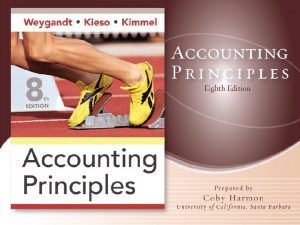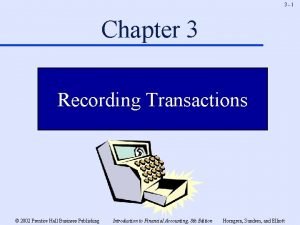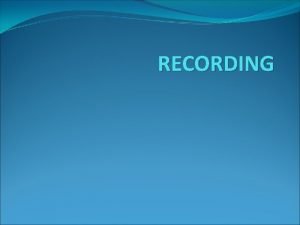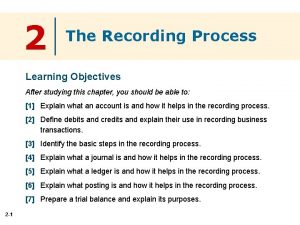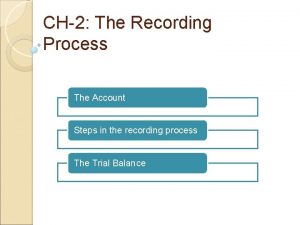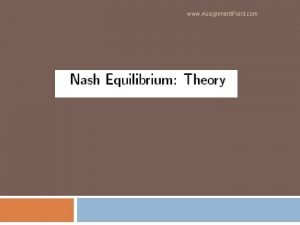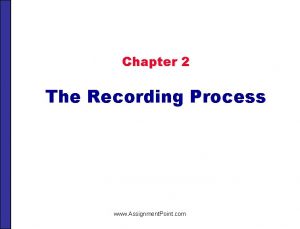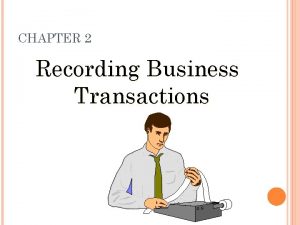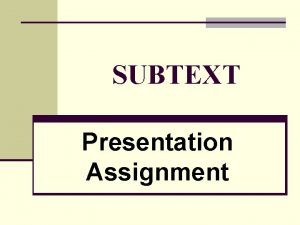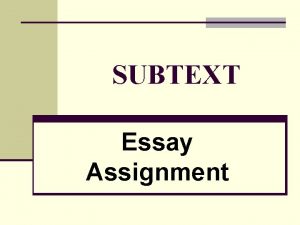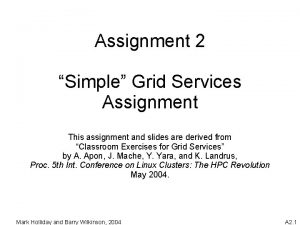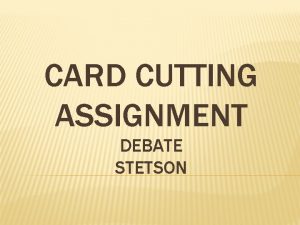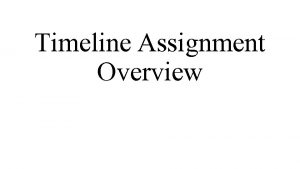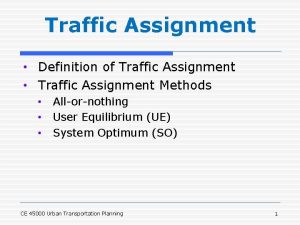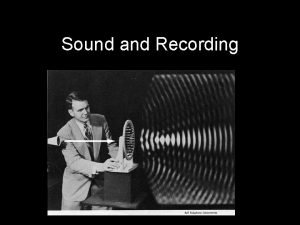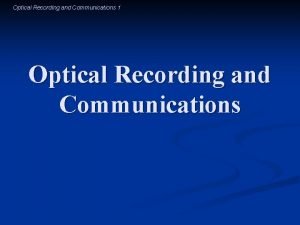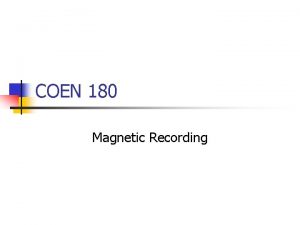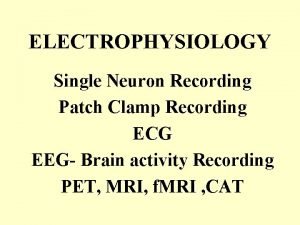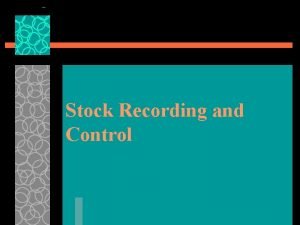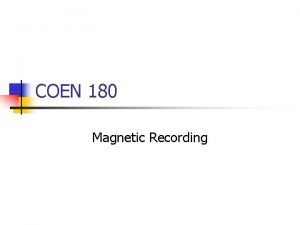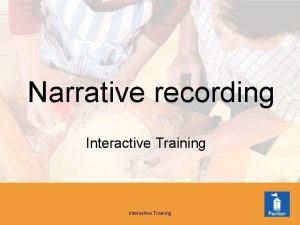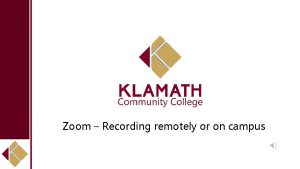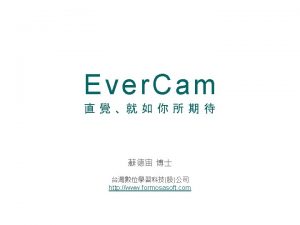Lecture on the Recording Process www Assignment Point































- Slides: 31

Lecture on the Recording Process www. Assignment. Point. com

The Account Record of increases and decreases in a specific asset, liability, equity, revenue, or expense item. Debit = “Left” Credit = “Right” An Account can be illustrated in a T-Account form.

Debits and Credits Double-entry accounting system Each transaction must affect two or more accounts to keep the basic accounting equation in balance. Recording done by debiting at least one account and crediting another. DEBITS must equal CREDITS. SO 2 Define debits and credits and explain their use in recording business transactions.

Debits and Credits If Debits are greater than Credits, the account will have a debit balance. Transaction #1 $10, 000 Transaction #3 8, 000 Balance $3, 000 Transaction #2 $15, 000 SO 2 Define debits and credits and explain their use in recording business transactions.

Debits and Credits If Credits are greater than Debits, the account will have a credit balance. Transaction #1 Balance $10, 000 $3, 000 Transaction #2 8, 000 Transaction #3 $1, 000 SO 2 Define debits and credits and explain their use in recording business transactions.

Debits and Credits Summary Normal Balance Debit Normal Balance Credit SO 2

Debits and Credits Summary Balance Sheet Income Statement Asset = Liability + Equity Revenue - Expense Debit Credit SO 2 Define debits and credits and explain their use in recording business transactions.

Assets and Liabilities Assets - Debits should exceed credits. Liabilities – Credits should exceed debits. The normal balance is on the increase side. SO 2 Define debits and credits and explain their use in recording business transactions.

Owners’ Equity Owner’s investments and revenues increase owner’s equity (credit). Owner’s drawings and expenses decrease owner’s equity (debit). SO 2 Define debits and credits and explain their use in recording business transactions.

Revenue and Expense The purpose of earning revenues is to benefit the owner(s). The effect of debits and credits on revenue accounts is the same as their effect on Owner’s Capital. Expenses have the opposite effect: expenses decrease owner’s equity. SO 2 Define debits and credits and explain their use in recording business transactions.

Expansion of the Basic Equation Relationship among the assets, liabilities and owner’s equity of a business: Basic Equation Illustration 2 -11 Assets = Liabilities + Owner’s Equity Expanded Basic Equation The equation must be in balance after every transaction. For every Debit there must be a Credit. SO 2 Define debits and credits and explain their use in recording business transactions.

Steps in the Recording Process Illustration 2 -12 Analyze each transaction Enter transaction in a journal Transfer journal information to ledger accounts Business documents, such as a sales slip, a check, a bill, or a cash register tape, provide evidence of the transaction. SO 3 Identify the basic steps in the recording process.

The Journal Book of original entry. Transactions recorded in chronological order. Contributions to the recording process: 1. Discloses the complete effects of a transaction. 2. Provides a chronological record of transactions. 3. Helps to prevent or locate errors because the debit and credit amounts can be easily compared. SO 4 Explain what a journal is and how it helps in the recording process.

Journalizing - Entering transaction data in the journal. Illustration: On September 1, Ray Neal invested $15, 000 cash in the business, and Softbyte purchased computer equipment for $7, 000 cash. Illustration 2 -13 General Journal Sept. 1 Cash 15, 000 R. Neal, Capital Computer equipment Cash 15, 000 7, 000 SO 4 Explain what a journal is and how it helps in the recording process.

Journalizing Simple and Compound Entries Illustration: Assume that on July 1, Butler Company purchases a delivery truck costing $14, 000. It pays $8, 000 cash now and agrees to pay the remaining $6, 000 on account. Illustration 2 -14 General Journal Sept. 1 Delivery equipment 14, 000 Cash 8, 000 Accounts payable 6, 000 SO 4 Explain what a journal is and how it helps in the recording process.

The Ledger A General Ledger contains the entire group of accounts maintained by a company. The General Ledger includes all the asset, liability, owner’s equity, revenue and expense accounts. Illustration 2 -15 SO 5 Explain what a ledger is and how it helps in the recording process.

Standard Form of Account T-account form used in accounting textbooks. In practice, the account forms used in ledgers are much more structured. Illustration 2 -16 SO 5 Explain what a ledger is and how it helps in the recording process.

Posting – the process of transferring amounts from the journal to the ledger accounts. Illustration 2 -17 SO 6 Explain what posting is and how it helps in the recording process.

Chart of Accounts and account numbers arranged in sequence in which they are presented in the financial statements. Illustration 2 -18 SO 6 Explain what posting is and how it helps in the recording process.

The Recording Process Illustrated Follow these steps: 1. Determine what type of account is involved. Illustration 2 -19 2. Determine what items increased or decreased and by how much. 3. Translate the increases and decreases into debits and credits. LO 6 Explain what posting is and how it helps in the recording process.

The Recording Process Illustrated Illustration 2 -20 LO 6 Explain what posting is and how it helps in the recording process.

The Recording Process Illustrated Illustration 2 -21

The Recording Process Illustrated Illustration 2 -22

The Recording Process Illustrated Illustration 2 -23

The Recording Process Illustrated Illustration 2 -24

The Recording Process Illustrated Illustration 2 -25

The Recording Process Illustrated Illustration 2 -26

The Recording Process Illustrated Illustration 2 -27

The Recording Process Illustrated Illustration 2 -28

The Trial Balance Illustration 2 -31 A list of accounts and their balances at a given time. Purpose is to prove that debits equal credits. LO 7 Prepare a trial balance and explain its purposes.

The Trial Balance Limitations of a Trial Balance The trial balance may balance even when 1. a transaction is not journalized, 2. a correct journal entry is not posted, 3. a journal entry is posted twice, 4. incorrect accounts are used in journalizing or posting, or 5. offsetting errors are made in recording the amount of a transaction. LO 7 Prepare a trial balance and explain its purposes.
 01:640:244 lecture notes - lecture 15: plat, idah, farad
01:640:244 lecture notes - lecture 15: plat, idah, farad Steps in the recording process
Steps in the recording process Recording process in accounting
Recording process in accounting Process recording example
Process recording example Recording process in accounting
Recording process in accounting Recording in accounting process
Recording in accounting process Condensed recording in social case work
Condensed recording in social case work Process recording objectives
Process recording objectives Steps in recording process
Steps in recording process Customs in things fall apart
Customs in things fall apart Assignment point.com
Assignment point.com Www.assignment
Www.assignment Point assignment clustering
Point assignment clustering Welcome to my presentation
Welcome to my presentation Assignment point.com
Assignment point.com Welcome to our presentation
Welcome to our presentation Slidetodoc.com
Slidetodoc.com Assignment point
Assignment point Www.assignmentpoint.com
Www.assignmentpoint.com Assignment point.com
Assignment point.com Www.assignmentpoint.com
Www.assignmentpoint.com Assignment point.com
Assignment point.com Assignment point.com
Assignment point.com Assignment point.com
Assignment point.com Assignment point.com
Assignment point.com Supportive model assignment
Supportive model assignment Assignment point
Assignment point Binary to decimal
Binary to decimal Hát kết hợp bộ gõ cơ thể
Hát kết hợp bộ gõ cơ thể Lp html
Lp html Bổ thể
Bổ thể Tỉ lệ cơ thể trẻ em
Tỉ lệ cơ thể trẻ em




